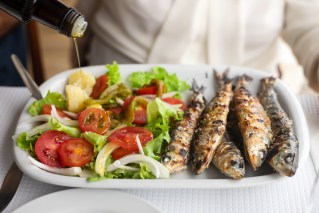Cook it: Dominique Ansel’s famous Cronut recipe


I love making this recipe . . . because—what can I say?—it changed the world. This is a version designed for the home cook.
Cronut pastry
Skill Level Advanced
Time 1 hour two days before; 1 hour one day before; 2 hours the day of
Yield 12 At-Home CronutTM pastries
Ingredients
Ganache of your choice 1 batch 1 batch
(pages 205 to 207)
Flavoured sugar of your choice
(page 208)
Glaze of your choice (page 208)
At-home CronutTM pastry Dough
Strong flour 3¾ cups, plus 525 grams, plus
more as needed
for dusting
Kosher salt 1 tablespoon + 6 grams
2 teaspoons
Granulated sugar ¼ cup + 64 grams
1 tablespoon
Instant yeast (preferably SAF 1 tablespoon + 11 grams
Gold Label)* 1½ teaspoons
Water, cold 1 cup + 250 grams
2 tablespoons
Egg white (large) 1 each 1 each (30 grams)
Unsalted butter (84% butterfat), 8 tablespoons 112 grams
softened
Pouring cream (35% milk fat) 1 tablespoon 15 grams
Cooking oil spray as needed as needed
Butter Block
Unsalted butter (84% butterfat), 18 tablespoons 251 grams
softened
Grapeseed oil as needed as needed
Glaze of your choice (page 208) as needed as needed
Decorating sugar of your choice as needed as needed
(page 208)
Read our recipe road test here
Two Days Before
Make Ganache
Prepare one of the ganache recipes on pages 205 to 207 and refrigerate until needed.
Make at-home Cronut™ pastry Dough
Combine the strong flour, salt, sugar, yeast, water, egg whites, butter and cream in a stand mixer fitted with a dough hook. Mix until just combined, about 3 minutes. When finished the dough will be rough and have very little gluten development.
Lightly grease a medium bowl with cooking oil spray. Transfer the dough to the bowl. Cover with plastic wrap pressed directly on the surface of the dough, to prevent a skin from forming. Proof the dough in a warm spot until doubled in size, 2 to 3 hours.
Remove the plastic wrap and punch down the dough by folding the edges into the centre, releasing as much of the gas as possible. On a piece of baking paper, shape into a 10-inch (25 cm) square. Transfer to a baking tray, still on the baking paper, and cover with plastic wrap. Refrigerate overnight.
Make Butter Block
Draw a 7-inch (18 cm) square on a piece of baking paper with a pencil. Flip the paper over so that the butter won’t come in contact with the pencil marks. Place the butter in the centre of the square and spread it evenly with an offset spatula to fill the square. Refrigerate overnight.
One Day Before
Laminate
Remove the butter from the refrigerator. It should still be soft enough to bend slightly without cracking. If it is still too firm, lightly beat it with a rolling pin on a lightly floured work surface until it becomes pliable. Make sure to press the butter back to its original 7-inch (18 cm) square after working it.
Remove the dough from the refrigerator, making sure it is very cold throughout. Place the dough on a floured work surface. Using the rolling pin, roll out the dough to a 10-inch (25.5 cm) square about 1 inch (2.5 cm) thick.
Arrange the butter block in the centre of the dough so it looks like a diamond in the centre of the square (rotated 45 degrees, with the corners of the butter block facing the centre of the dough sides). Pull the corners of the dough up and over to the centre of the butter block. Pinch the seams of dough together to seal the butter inside. You should have a square slightly larger than the butter block.
Very lightly dust the work surface with flour to ensure the dough doesn’t stick. With a rolling pin, using steady, even pressure, roll out the dough from the centre. When finished, you should have a 20-inch (50 cm) square about ¼ inch (6 mm) thick.*
Fold the dough in half horizontally, making sure to line up the edges so you are left with a rectangle. Then fold the dough vertically. You should have a 10-inch (25.5 cm) square of dough with 4 layers. Wrap tightly in plastic wrap and refrigerate for 1 hour.
Repeat steps 3 and 4. Cover tightly with plastic wrap and refrigerate overnight.
The Day of
Cut dough
On a lightly floured work surface, roll out the dough to a 15-inch (40 cm) square about ½ inch (1.3 cm) thick. Transfer the dough to a half baking tray, cover with plastic wrap, and refrigerate for 1 hour to relax.
Using a 3½-inch (9 cm) ring cutter, cut 12 rounds. Cut out the centre of each round with a 1-inch (2.5 cm) ring cutter to create the doughnut shape.
Line a baking tray with baling paper and lightly dust the paper with flour. Place the At-Home CronutTM pastries on the tray, spacing them about 3 inches (8 cm) apart. Lightly spray a piece of plastic wrap with cooking oil spray and lay it on top of the pastries. Proof in a warm spot until tripled in size, about 2 hours.±
Fry Dough
Heat the grapeseed oil in a large saucepan until it reaches 350°F (175°C). Use a deep-frying thermometer to verify the oil is at the right temperature.‡ Line a platter with several layers of paper towels for draining.
Gently place 3 or 4 of them at a time into the hot oil. Fry for about 90 seconds on each side, flipping once, until golden brown. Remove from the oil with a slotted spoon and drain on the paper towels.
Check that the oil is at the right temperature. If not, let it heat up again before frying the next batch. Continue until all of them are fried.
Let cool completely before filling.
Make glaze
Prepare the glaze on page 208 that corresponds to your choice of ganache.
Make flavoured Sugar
Prepare the decorating sugar on page 208 that corresponds to your choice of ganache.
Assemble
Transfer the ganache to a stand mixer fitted with a whisk. Whip on high speed until the ganache holds a stiff peak. (If using the Champagne-chocolate ganache, simply whisk it until smooth. It will be quite thick already.)
Cut the tip of a piping bag to snugly fit the Bismarck tip. Using a rubber spatula, place 2 large scoops of ganache in a piping bag so that it is one-third full. Push the ganache down toward the tip of the bag.
Place the decorating sugar that corresponds to your choice of ganache and glaze in a bowl.
Arrange each At-Home CronutTM pastry so that the flatter side is facing up. Inject the ganache through the top of the pastry in four different spots, evenly spaced. As you pipe the ganache, you should feel the pastry getting heavier in your hand.
Place the pastry on its side. Roll in the corresponding sugar, coating the outside edges.
If the glaze has cooled, microwave it for a few seconds to warm until soft. Cut the tip of a piping bag to snugly fit a #803 plain tip. Using a rubber spatula, transfer the glaze to the bag. Push the glaze down toward the tip of the bag.
Pipe a ring of glaze around the top of each At-Home Cronut pastry, making sure to cover all the holes created from the filling. Keep in mind that the glaze will continue to spread slightly as it cools. Let the glaze set for about 15 minutes before serving.
Serving Instructions Because the At-Home CronutTM pastry is cream-filled, it must be served at room temperature.
Storage Instructions Consume within 8 hours of frying. Leftover ganache can be stored in a closed airtight container in the refrigerator for 2 days. Leftover flavoured sugar can keep in a closed airtight container for weeks and can be used to macerate fruits or sweeten drinks.
* Instant yeast is often used for doughs with higher sugar content, because this yeast needs less water to react and sugar tends to pull water from dough. You can substitute the same quantity of active dry yeast, but may get a denser final product.
* This is not the typical lamination technique and is unique to this recipe.
When rolling out dough, you want to use as little flour as possible. The more flour you incorporate into the dough, the tougher it will be to roll out, and when you fry the At-Home Cronut™ pastries they will flake apart.
± It’s best to proof At-Home Cronut pastries in a warm, humid place. But if the proofing area is too warm, the butter will melt, so do not place the pastries on top of the oven or near another direct source of heat.
‡ The temperature of the oil is very important to the frying process. If it is too low, the pastries will be greasy; too high, the inside will be undercooked while the outside is burnt.
Champagne-Chocolate Ganache
Yield Ganache for 12 At-Home CronutTM pastries
Ingredients
Water 2 tablespoons 26 grams
Champagne ¼ cup + 2 tablespoons 102 grams
Unsweetened cocoa powder 1½ tablespoons 9 grams
Pouring cream (35% milk fat) ½ cup 115 grams
Egg yolks (large) 3 each 3 each (60 grams)
Granulated sugar 3 tablespoons 38 grams
Dark chocolate (66% cocoa 1 cup + 1 tablespoon 165 grams
content), finely chopped
Method
Combine the water, 2 tablespoons (26 grams) of the Champagne and the cocoa powder in a small bowl. Mix to a smooth paste.
Combine the cream and the remaining ¼ cup (76 grams) Champagne in a small saucepan and bring to a boil over medium heat. Remove from the heat.
 Whisk the egg yolks and granulated sugar together in a small bowl. Stream one-third of the hot cream mixture into the egg yolks, whisking constantly until fully blended, to temper them. Whisk the tempered yolks into the remaining hot cream. Return the saucepan to medium heat.
Whisk the egg yolks and granulated sugar together in a small bowl. Stream one-third of the hot cream mixture into the egg yolks, whisking constantly until fully blended, to temper them. Whisk the tempered yolks into the remaining hot cream. Return the saucepan to medium heat.
Keep whisking! Continue to cook the custard over medium heat until it reaches 185°F (85°C). The custard will turn pale yellow and thicken so that it coats the back of a spoon. Remove from the heat and whisk in the cocoa powder paste until fully incorporated.
Place the chocolate in a medium heatproof bowl. Strain the custard through a small sieve over the chocolate. Let stand for 30 seconds.
Whisk the chocolate and custard until smooth. When finished, the ganache will have the consistency of yoghurt. Reserve ¼ cup (50 grams) for the glaze. Cover with plastic wrap pressed directly onto the surface of the ganache, to prevent a skin from forming. Refrigerate overnight to set.
Recipe and image from Secret Recipes by Dominique Ansel (Murdoch Books) $49.99 available now in all good bookstores and online.








